Exploring Self and Identity: A Sociological Perspective Analysis
VerifiedAdded on 2022/02/04
|8
|3734
|84
Homework Assignment
AI Summary
This assignment explores the sociological and anthropological perspectives on the self, covering key concepts such as the differences and overlaps between sociology and anthropology, and the sociological views on understanding the self and others. It delves into how individuals view themselves as products of socialization and examines various theories about the social self. The assignment discusses the contributions of anthropology to understanding the self and the complementary relationship between culture and self, including the cultural construction of self, social identity, and identity struggles. Furthermore, the assignment analyzes the bioecological systems perspective, the impact of globalization on self and identity, the role of culture in shaping mindset, and the influence of the internet. It also addresses individualism and collectivism in the context of self and identity, providing insights into achieving a sense of self in multicultural and dynamic situations. This analysis is crucial for understanding how social structures, interactions, and cultural contexts shape individual identity and behavior.
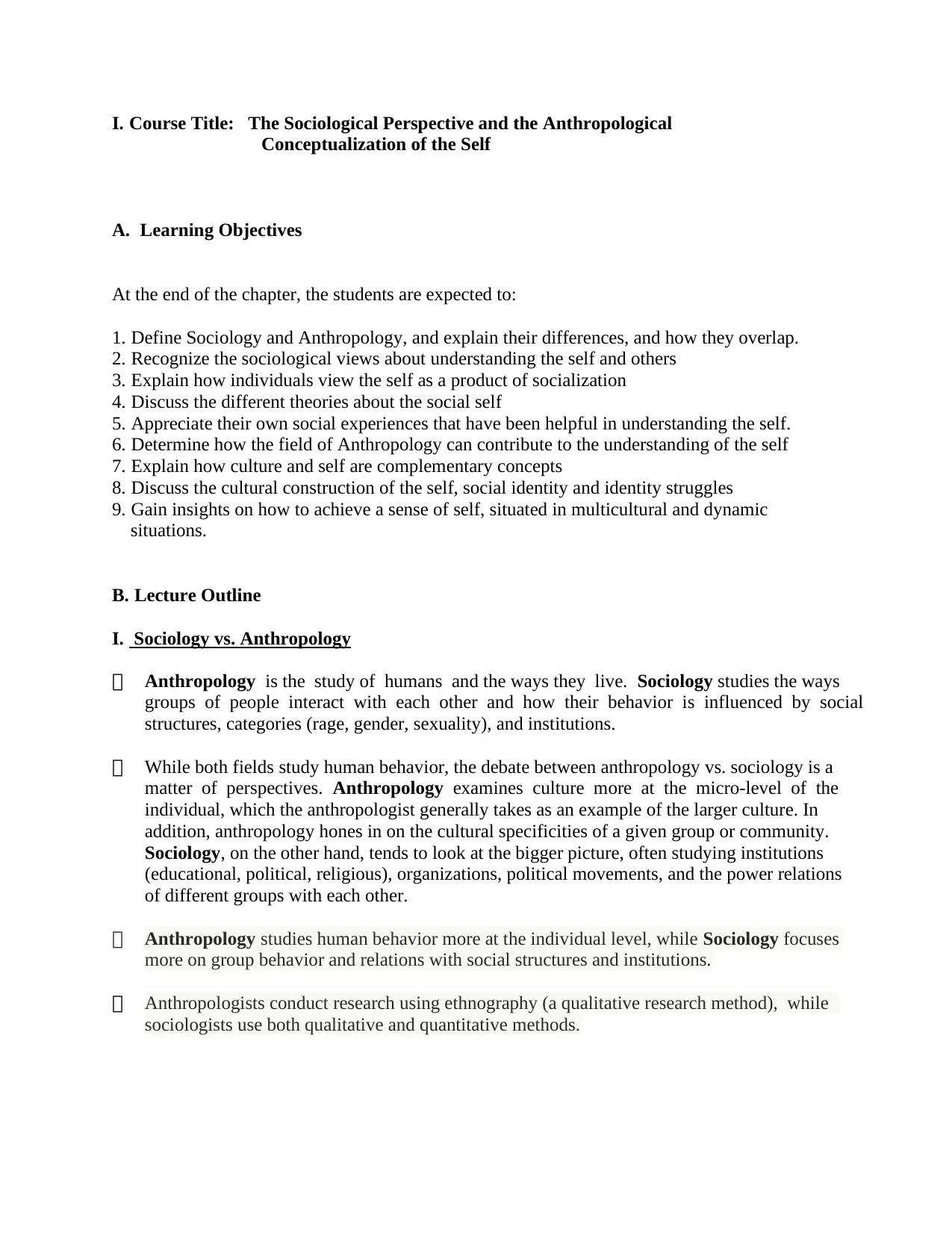
I. Course Title: The Sociological Perspective and the Anthropological
Conceptualization of the Self
A. Learning Objectives
At the end of the chapter, the students are expected to:
1. Define Sociology and Anthropology, and explain their differences, and how they overlap.
2. Recognize the sociological views about understanding the self and others
3. Explain how individuals view the self as a product of socialization
4. Discuss the different theories about the social self
5. Appreciate their own social experiences that have been helpful in understanding the self.
6. Determine how the field of Anthropology can contribute to the understanding of the self
7. Explain how culture and self are complementary concepts
8. Discuss the cultural construction of the self, social identity and identity struggles
9. Gain insights on how to achieve a sense of self, situated in multicultural and dynamic
situations.
B. Lecture Outline
I. Sociology vs. Anthropology
Anthropology is the study of humans and the ways they live. Sociology studies the ways
groups of people interact with each other and how their behavior is influenced by social
structures, categories (rage, gender, sexuality), and institutions.
While both fields study human behavior, the debate between anthropology vs. sociology is a
matter of perspectives. Anthropology examines culture more at the micro-level of the
individual, which the anthropologist generally takes as an example of the larger culture. In
addition, anthropology hones in on the cultural specificities of a given group or community.
Sociology, on the other hand, tends to look at the bigger picture, often studying institutions
(educational, political, religious), organizations, political movements, and the power relations
of different groups with each other.
Anthropology studies human behavior more at the individual level, while Sociology focuses
more on group behavior and relations with social structures and institutions.
Anthropologists conduct research using ethnography (a qualitative research method), while
sociologists use both qualitative and quantitative methods.
Conceptualization of the Self
A. Learning Objectives
At the end of the chapter, the students are expected to:
1. Define Sociology and Anthropology, and explain their differences, and how they overlap.
2. Recognize the sociological views about understanding the self and others
3. Explain how individuals view the self as a product of socialization
4. Discuss the different theories about the social self
5. Appreciate their own social experiences that have been helpful in understanding the self.
6. Determine how the field of Anthropology can contribute to the understanding of the self
7. Explain how culture and self are complementary concepts
8. Discuss the cultural construction of the self, social identity and identity struggles
9. Gain insights on how to achieve a sense of self, situated in multicultural and dynamic
situations.
B. Lecture Outline
I. Sociology vs. Anthropology
Anthropology is the study of humans and the ways they live. Sociology studies the ways
groups of people interact with each other and how their behavior is influenced by social
structures, categories (rage, gender, sexuality), and institutions.
While both fields study human behavior, the debate between anthropology vs. sociology is a
matter of perspectives. Anthropology examines culture more at the micro-level of the
individual, which the anthropologist generally takes as an example of the larger culture. In
addition, anthropology hones in on the cultural specificities of a given group or community.
Sociology, on the other hand, tends to look at the bigger picture, often studying institutions
(educational, political, religious), organizations, political movements, and the power relations
of different groups with each other.
Anthropology studies human behavior more at the individual level, while Sociology focuses
more on group behavior and relations with social structures and institutions.
Anthropologists conduct research using ethnography (a qualitative research method), while
sociologists use both qualitative and quantitative methods.
Paraphrase This Document
Need a fresh take? Get an instant paraphrase of this document with our AI Paraphraser
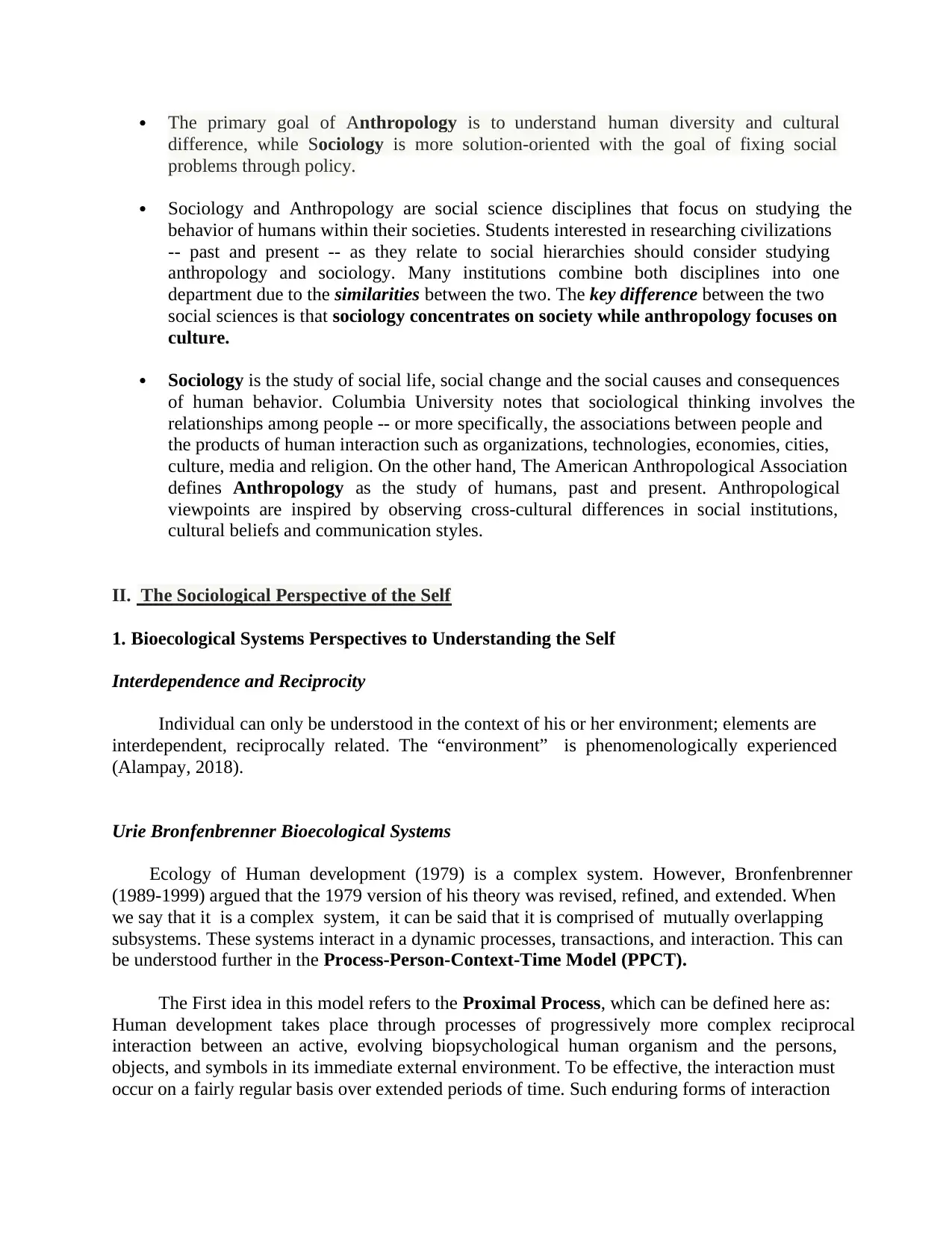
The primary goal of Anthropology is to understand human diversity and cultural
difference, while Sociology is more solution-oriented with the goal of fixing social
problems through policy.
Sociology and Anthropology are social science disciplines that focus on studying the
behavior of humans within their societies. Students interested in researching civilizations
-- past and present -- as they relate to social hierarchies should consider studying
anthropology and sociology. Many institutions combine both disciplines into one
department due to the similarities between the two. The key difference between the two
social sciences is that sociology concentrates on society while anthropology focuses on
culture.
Sociology is the study of social life, social change and the social causes and consequences
of human behavior. Columbia University notes that sociological thinking involves the
relationships among people -- or more specifically, the associations between people and
the products of human interaction such as organizations, technologies, economies, cities,
culture, media and religion. On the other hand, The American Anthropological Association
defines Anthropology as the study of humans, past and present. Anthropological
viewpoints are inspired by observing cross-cultural differences in social institutions,
cultural beliefs and communication styles.
II. The Sociological Perspective of the Self
1. Bioecological Systems Perspectives to Understanding the Self
Interdependence and Reciprocity
Individual can only be understood in the context of his or her environment; elements are
interdependent, reciprocally related. The “environment” is phenomenologically experienced
(Alampay, 2018).
Urie Bronfenbrenner Bioecological Systems
Ecology of Human development (1979) is a complex system. However, Bronfenbrenner
(1989-1999) argued that the 1979 version of his theory was revised, refined, and extended. When
we say that it is a complex system, it can be said that it is comprised of mutually overlapping
subsystems. These systems interact in a dynamic processes, transactions, and interaction. This can
be understood further in the Process-Person-Context-Time Model (PPCT).
The First idea in this model refers to the Proximal Process, which can be defined here as:
Human development takes place through processes of progressively more complex reciprocal
interaction between an active, evolving biopsychological human organism and the persons,
objects, and symbols in its immediate external environment. To be effective, the interaction must
occur on a fairly regular basis over extended periods of time. Such enduring forms of interaction
difference, while Sociology is more solution-oriented with the goal of fixing social
problems through policy.
Sociology and Anthropology are social science disciplines that focus on studying the
behavior of humans within their societies. Students interested in researching civilizations
-- past and present -- as they relate to social hierarchies should consider studying
anthropology and sociology. Many institutions combine both disciplines into one
department due to the similarities between the two. The key difference between the two
social sciences is that sociology concentrates on society while anthropology focuses on
culture.
Sociology is the study of social life, social change and the social causes and consequences
of human behavior. Columbia University notes that sociological thinking involves the
relationships among people -- or more specifically, the associations between people and
the products of human interaction such as organizations, technologies, economies, cities,
culture, media and religion. On the other hand, The American Anthropological Association
defines Anthropology as the study of humans, past and present. Anthropological
viewpoints are inspired by observing cross-cultural differences in social institutions,
cultural beliefs and communication styles.
II. The Sociological Perspective of the Self
1. Bioecological Systems Perspectives to Understanding the Self
Interdependence and Reciprocity
Individual can only be understood in the context of his or her environment; elements are
interdependent, reciprocally related. The “environment” is phenomenologically experienced
(Alampay, 2018).
Urie Bronfenbrenner Bioecological Systems
Ecology of Human development (1979) is a complex system. However, Bronfenbrenner
(1989-1999) argued that the 1979 version of his theory was revised, refined, and extended. When
we say that it is a complex system, it can be said that it is comprised of mutually overlapping
subsystems. These systems interact in a dynamic processes, transactions, and interaction. This can
be understood further in the Process-Person-Context-Time Model (PPCT).
The First idea in this model refers to the Proximal Process, which can be defined here as:
Human development takes place through processes of progressively more complex reciprocal
interaction between an active, evolving biopsychological human organism and the persons,
objects, and symbols in its immediate external environment. To be effective, the interaction must
occur on a fairly regular basis over extended periods of time. Such enduring forms of interaction
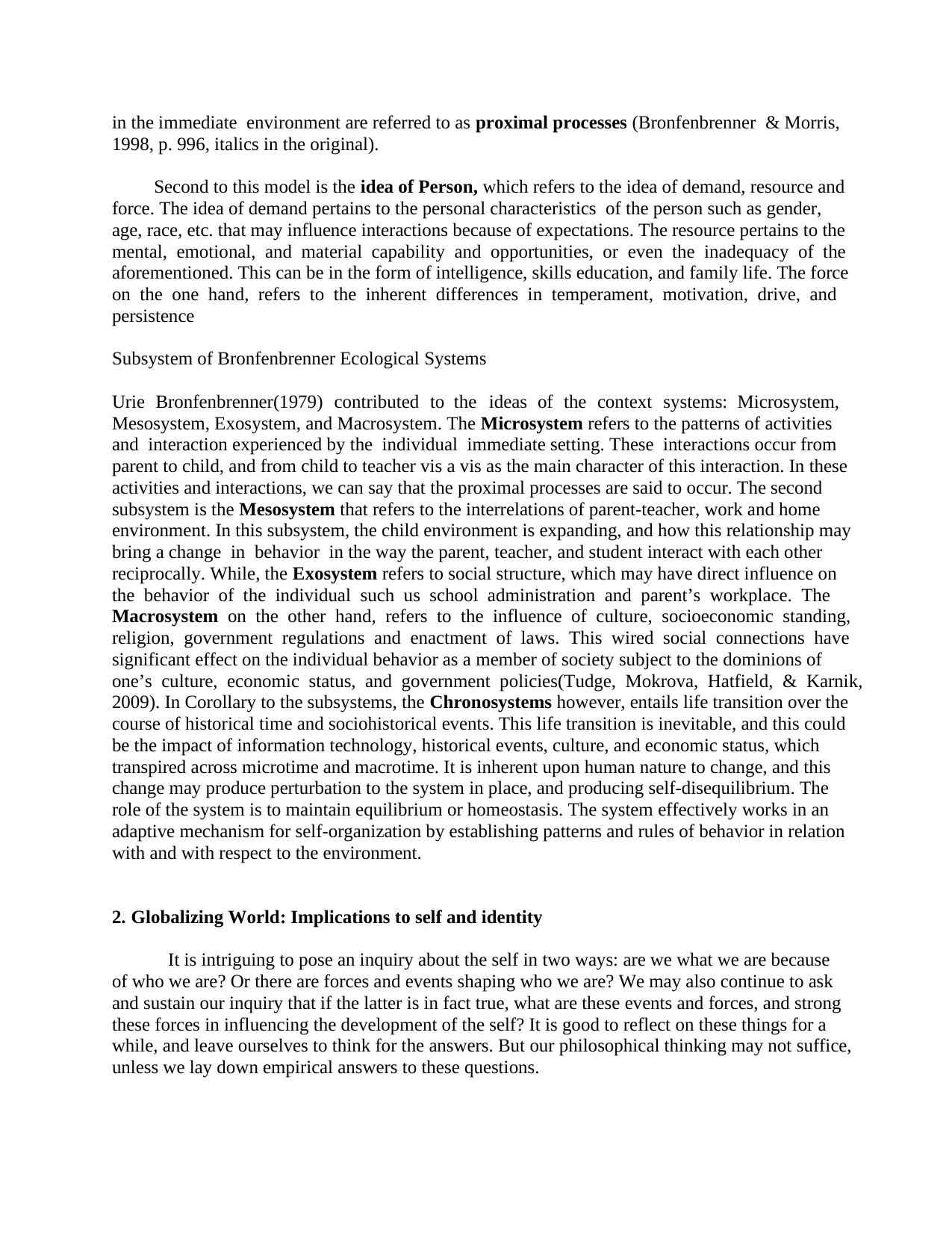
in the immediate environment are referred to as proximal processes (Bronfenbrenner & Morris,
1998, p. 996, italics in the original).
Second to this model is the idea of Person, which refers to the idea of demand, resource and
force. The idea of demand pertains to the personal characteristics of the person such as gender,
age, race, etc. that may influence interactions because of expectations. The resource pertains to the
mental, emotional, and material capability and opportunities, or even the inadequacy of the
aforementioned. This can be in the form of intelligence, skills education, and family life. The force
on the one hand, refers to the inherent differences in temperament, motivation, drive, and
persistence
Subsystem of Bronfenbrenner Ecological Systems
Urie Bronfenbrenner(1979) contributed to the ideas of the context systems: Microsystem,
Mesosystem, Exosystem, and Macrosystem. The Microsystem refers to the patterns of activities
and interaction experienced by the individual immediate setting. These interactions occur from
parent to child, and from child to teacher vis a vis as the main character of this interaction. In these
activities and interactions, we can say that the proximal processes are said to occur. The second
subsystem is the Mesosystem that refers to the interrelations of parent-teacher, work and home
environment. In this subsystem, the child environment is expanding, and how this relationship may
bring a change in behavior in the way the parent, teacher, and student interact with each other
reciprocally. While, the Exosystem refers to social structure, which may have direct influence on
the behavior of the individual such us school administration and parent’s workplace. The
Macrosystem on the other hand, refers to the influence of culture, socioeconomic standing,
religion, government regulations and enactment of laws. This wired social connections have
significant effect on the individual behavior as a member of society subject to the dominions of
one’s culture, economic status, and government policies(Tudge, Mokrova, Hatfield, & Karnik,
2009). In Corollary to the subsystems, the Chronosystems however, entails life transition over the
course of historical time and sociohistorical events. This life transition is inevitable, and this could
be the impact of information technology, historical events, culture, and economic status, which
transpired across microtime and macrotime. It is inherent upon human nature to change, and this
change may produce perturbation to the system in place, and producing self-disequilibrium. The
role of the system is to maintain equilibrium or homeostasis. The system effectively works in an
adaptive mechanism for self-organization by establishing patterns and rules of behavior in relation
with and with respect to the environment.
2. Globalizing World: Implications to self and identity
It is intriguing to pose an inquiry about the self in two ways: are we what we are because
of who we are? Or there are forces and events shaping who we are? We may also continue to ask
and sustain our inquiry that if the latter is in fact true, what are these events and forces, and strong
these forces in influencing the development of the self? It is good to reflect on these things for a
while, and leave ourselves to think for the answers. But our philosophical thinking may not suffice,
unless we lay down empirical answers to these questions.
1998, p. 996, italics in the original).
Second to this model is the idea of Person, which refers to the idea of demand, resource and
force. The idea of demand pertains to the personal characteristics of the person such as gender,
age, race, etc. that may influence interactions because of expectations. The resource pertains to the
mental, emotional, and material capability and opportunities, or even the inadequacy of the
aforementioned. This can be in the form of intelligence, skills education, and family life. The force
on the one hand, refers to the inherent differences in temperament, motivation, drive, and
persistence
Subsystem of Bronfenbrenner Ecological Systems
Urie Bronfenbrenner(1979) contributed to the ideas of the context systems: Microsystem,
Mesosystem, Exosystem, and Macrosystem. The Microsystem refers to the patterns of activities
and interaction experienced by the individual immediate setting. These interactions occur from
parent to child, and from child to teacher vis a vis as the main character of this interaction. In these
activities and interactions, we can say that the proximal processes are said to occur. The second
subsystem is the Mesosystem that refers to the interrelations of parent-teacher, work and home
environment. In this subsystem, the child environment is expanding, and how this relationship may
bring a change in behavior in the way the parent, teacher, and student interact with each other
reciprocally. While, the Exosystem refers to social structure, which may have direct influence on
the behavior of the individual such us school administration and parent’s workplace. The
Macrosystem on the other hand, refers to the influence of culture, socioeconomic standing,
religion, government regulations and enactment of laws. This wired social connections have
significant effect on the individual behavior as a member of society subject to the dominions of
one’s culture, economic status, and government policies(Tudge, Mokrova, Hatfield, & Karnik,
2009). In Corollary to the subsystems, the Chronosystems however, entails life transition over the
course of historical time and sociohistorical events. This life transition is inevitable, and this could
be the impact of information technology, historical events, culture, and economic status, which
transpired across microtime and macrotime. It is inherent upon human nature to change, and this
change may produce perturbation to the system in place, and producing self-disequilibrium. The
role of the system is to maintain equilibrium or homeostasis. The system effectively works in an
adaptive mechanism for self-organization by establishing patterns and rules of behavior in relation
with and with respect to the environment.
2. Globalizing World: Implications to self and identity
It is intriguing to pose an inquiry about the self in two ways: are we what we are because
of who we are? Or there are forces and events shaping who we are? We may also continue to ask
and sustain our inquiry that if the latter is in fact true, what are these events and forces, and strong
these forces in influencing the development of the self? It is good to reflect on these things for a
while, and leave ourselves to think for the answers. But our philosophical thinking may not suffice,
unless we lay down empirical answers to these questions.
⊘ This is a preview!⊘
Do you want full access?
Subscribe today to unlock all pages.

Trusted by 1+ million students worldwide
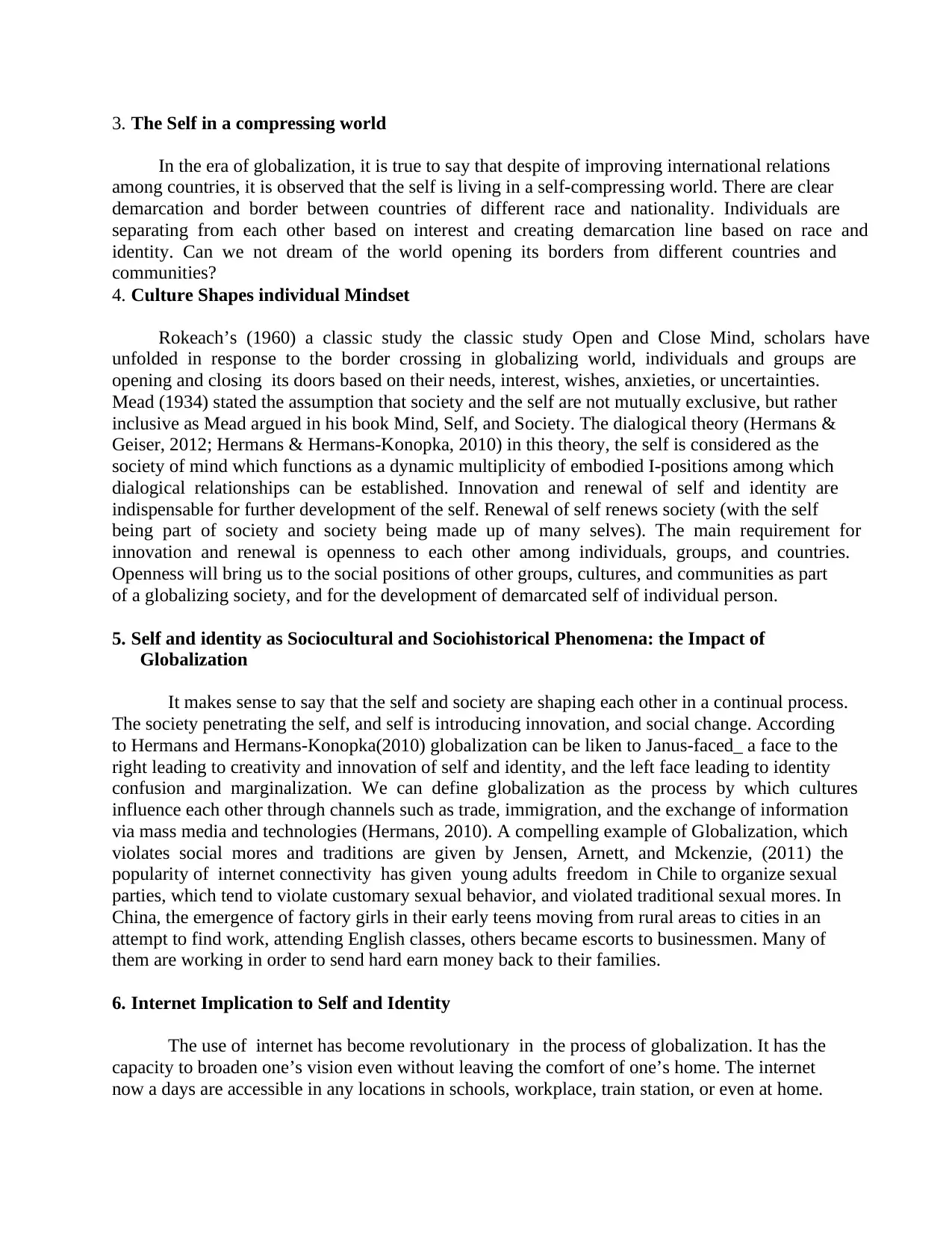
3. The Self in a compressing world
In the era of globalization, it is true to say that despite of improving international relations
among countries, it is observed that the self is living in a self-compressing world. There are clear
demarcation and border between countries of different race and nationality. Individuals are
separating from each other based on interest and creating demarcation line based on race and
identity. Can we not dream of the world opening its borders from different countries and
communities?
4. Culture Shapes individual Mindset
Rokeach’s (1960) a classic study the classic study Open and Close Mind, scholars have
unfolded in response to the border crossing in globalizing world, individuals and groups are
opening and closing its doors based on their needs, interest, wishes, anxieties, or uncertainties.
Mead (1934) stated the assumption that society and the self are not mutually exclusive, but rather
inclusive as Mead argued in his book Mind, Self, and Society. The dialogical theory (Hermans &
Geiser, 2012; Hermans & Hermans-Konopka, 2010) in this theory, the self is considered as the
society of mind which functions as a dynamic multiplicity of embodied I-positions among which
dialogical relationships can be established. Innovation and renewal of self and identity are
indispensable for further development of the self. Renewal of self renews society (with the self
being part of society and society being made up of many selves). The main requirement for
innovation and renewal is openness to each other among individuals, groups, and countries.
Openness will bring us to the social positions of other groups, cultures, and communities as part
of a globalizing society, and for the development of demarcated self of individual person.
5. Self and identity as Sociocultural and Sociohistorical Phenomena: the Impact of
Globalization
It makes sense to say that the self and society are shaping each other in a continual process.
The society penetrating the self, and self is introducing innovation, and social change. According
to Hermans and Hermans-Konopka(2010) globalization can be liken to Janus-faced_ a face to the
right leading to creativity and innovation of self and identity, and the left face leading to identity
confusion and marginalization. We can define globalization as the process by which cultures
influence each other through channels such as trade, immigration, and the exchange of information
via mass media and technologies (Hermans, 2010). A compelling example of Globalization, which
violates social mores and traditions are given by Jensen, Arnett, and Mckenzie, (2011) the
popularity of internet connectivity has given young adults freedom in Chile to organize sexual
parties, which tend to violate customary sexual behavior, and violated traditional sexual mores. In
China, the emergence of factory girls in their early teens moving from rural areas to cities in an
attempt to find work, attending English classes, others became escorts to businessmen. Many of
them are working in order to send hard earn money back to their families.
6. Internet Implication to Self and Identity
The use of internet has become revolutionary in the process of globalization. It has the
capacity to broaden one’s vision even without leaving the comfort of one’s home. The internet
now a days are accessible in any locations in schools, workplace, train station, or even at home.
In the era of globalization, it is true to say that despite of improving international relations
among countries, it is observed that the self is living in a self-compressing world. There are clear
demarcation and border between countries of different race and nationality. Individuals are
separating from each other based on interest and creating demarcation line based on race and
identity. Can we not dream of the world opening its borders from different countries and
communities?
4. Culture Shapes individual Mindset
Rokeach’s (1960) a classic study the classic study Open and Close Mind, scholars have
unfolded in response to the border crossing in globalizing world, individuals and groups are
opening and closing its doors based on their needs, interest, wishes, anxieties, or uncertainties.
Mead (1934) stated the assumption that society and the self are not mutually exclusive, but rather
inclusive as Mead argued in his book Mind, Self, and Society. The dialogical theory (Hermans &
Geiser, 2012; Hermans & Hermans-Konopka, 2010) in this theory, the self is considered as the
society of mind which functions as a dynamic multiplicity of embodied I-positions among which
dialogical relationships can be established. Innovation and renewal of self and identity are
indispensable for further development of the self. Renewal of self renews society (with the self
being part of society and society being made up of many selves). The main requirement for
innovation and renewal is openness to each other among individuals, groups, and countries.
Openness will bring us to the social positions of other groups, cultures, and communities as part
of a globalizing society, and for the development of demarcated self of individual person.
5. Self and identity as Sociocultural and Sociohistorical Phenomena: the Impact of
Globalization
It makes sense to say that the self and society are shaping each other in a continual process.
The society penetrating the self, and self is introducing innovation, and social change. According
to Hermans and Hermans-Konopka(2010) globalization can be liken to Janus-faced_ a face to the
right leading to creativity and innovation of self and identity, and the left face leading to identity
confusion and marginalization. We can define globalization as the process by which cultures
influence each other through channels such as trade, immigration, and the exchange of information
via mass media and technologies (Hermans, 2010). A compelling example of Globalization, which
violates social mores and traditions are given by Jensen, Arnett, and Mckenzie, (2011) the
popularity of internet connectivity has given young adults freedom in Chile to organize sexual
parties, which tend to violate customary sexual behavior, and violated traditional sexual mores. In
China, the emergence of factory girls in their early teens moving from rural areas to cities in an
attempt to find work, attending English classes, others became escorts to businessmen. Many of
them are working in order to send hard earn money back to their families.
6. Internet Implication to Self and Identity
The use of internet has become revolutionary in the process of globalization. It has the
capacity to broaden one’s vision even without leaving the comfort of one’s home. The internet
now a days are accessible in any locations in schools, workplace, train station, or even at home.
Paraphrase This Document
Need a fresh take? Get an instant paraphrase of this document with our AI Paraphraser
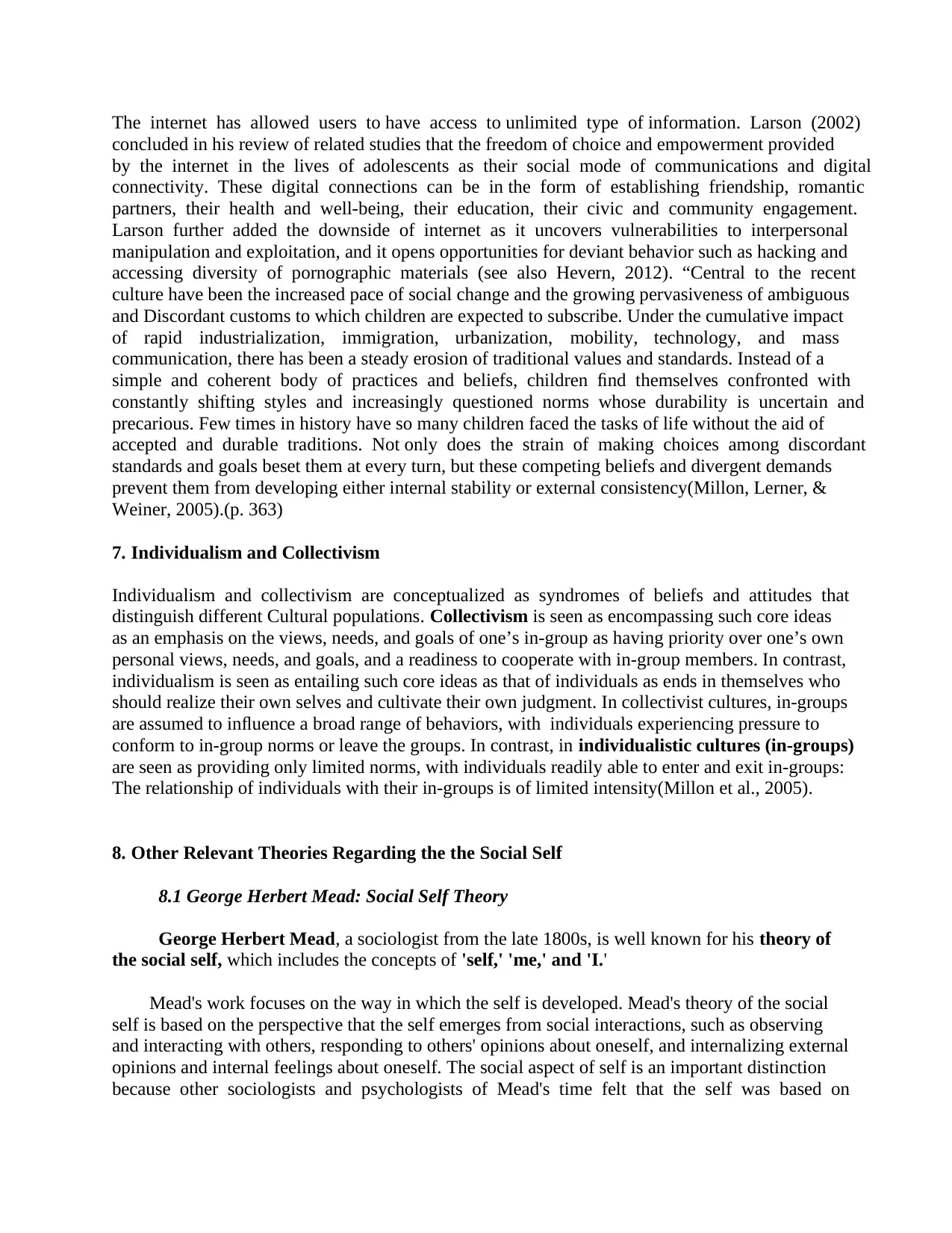
The internet has allowed users to have access to unlimited type of information. Larson (2002)
concluded in his review of related studies that the freedom of choice and empowerment provided
by the internet in the lives of adolescents as their social mode of communications and digital
connectivity. These digital connections can be in the form of establishing friendship, romantic
partners, their health and well-being, their education, their civic and community engagement.
Larson further added the downside of internet as it uncovers vulnerabilities to interpersonal
manipulation and exploitation, and it opens opportunities for deviant behavior such as hacking and
accessing diversity of pornographic materials (see also Hevern, 2012). “Central to the recent
culture have been the increased pace of social change and the growing pervasiveness of ambiguous
and Discordant customs to which children are expected to subscribe. Under the cumulative impact
of rapid industrialization, immigration, urbanization, mobility, technology, and mass
communication, there has been a steady erosion of traditional values and standards. Instead of a
simple and coherent body of practices and beliefs, children find themselves confronted with
constantly shifting styles and increasingly questioned norms whose durability is uncertain and
precarious. Few times in history have so many children faced the tasks of life without the aid of
accepted and durable traditions. Not only does the strain of making choices among discordant
standards and goals beset them at every turn, but these competing beliefs and divergent demands
prevent them from developing either internal stability or external consistency(Millon, Lerner, &
Weiner, 2005).(p. 363)
7. Individualism and Collectivism
Individualism and collectivism are conceptualized as syndromes of beliefs and attitudes that
distinguish different Cultural populations. Collectivism is seen as encompassing such core ideas
as an emphasis on the views, needs, and goals of one’s in-group as having priority over one’s own
personal views, needs, and goals, and a readiness to cooperate with in-group members. In contrast,
individualism is seen as entailing such core ideas as that of individuals as ends in themselves who
should realize their own selves and cultivate their own judgment. In collectivist cultures, in-groups
are assumed to influence a broad range of behaviors, with individuals experiencing pressure to
conform to in-group norms or leave the groups. In contrast, in individualistic cultures (in-groups)
are seen as providing only limited norms, with individuals readily able to enter and exit in-groups:
The relationship of individuals with their in-groups is of limited intensity(Millon et al., 2005).
8. Other Relevant Theories Regarding the the Social Self
8.1 George Herbert Mead: Social Self Theory
George Herbert Mead, a sociologist from the late 1800s, is well known for his theory of
the social self, which includes the concepts of 'self,' 'me,' and 'I.'
Mead's work focuses on the way in which the self is developed. Mead's theory of the social
self is based on the perspective that the self emerges from social interactions, such as observing
and interacting with others, responding to others' opinions about oneself, and internalizing external
opinions and internal feelings about oneself. The social aspect of self is an important distinction
because other sociologists and psychologists of Mead's time felt that the self was based on
concluded in his review of related studies that the freedom of choice and empowerment provided
by the internet in the lives of adolescents as their social mode of communications and digital
connectivity. These digital connections can be in the form of establishing friendship, romantic
partners, their health and well-being, their education, their civic and community engagement.
Larson further added the downside of internet as it uncovers vulnerabilities to interpersonal
manipulation and exploitation, and it opens opportunities for deviant behavior such as hacking and
accessing diversity of pornographic materials (see also Hevern, 2012). “Central to the recent
culture have been the increased pace of social change and the growing pervasiveness of ambiguous
and Discordant customs to which children are expected to subscribe. Under the cumulative impact
of rapid industrialization, immigration, urbanization, mobility, technology, and mass
communication, there has been a steady erosion of traditional values and standards. Instead of a
simple and coherent body of practices and beliefs, children find themselves confronted with
constantly shifting styles and increasingly questioned norms whose durability is uncertain and
precarious. Few times in history have so many children faced the tasks of life without the aid of
accepted and durable traditions. Not only does the strain of making choices among discordant
standards and goals beset them at every turn, but these competing beliefs and divergent demands
prevent them from developing either internal stability or external consistency(Millon, Lerner, &
Weiner, 2005).(p. 363)
7. Individualism and Collectivism
Individualism and collectivism are conceptualized as syndromes of beliefs and attitudes that
distinguish different Cultural populations. Collectivism is seen as encompassing such core ideas
as an emphasis on the views, needs, and goals of one’s in-group as having priority over one’s own
personal views, needs, and goals, and a readiness to cooperate with in-group members. In contrast,
individualism is seen as entailing such core ideas as that of individuals as ends in themselves who
should realize their own selves and cultivate their own judgment. In collectivist cultures, in-groups
are assumed to influence a broad range of behaviors, with individuals experiencing pressure to
conform to in-group norms or leave the groups. In contrast, in individualistic cultures (in-groups)
are seen as providing only limited norms, with individuals readily able to enter and exit in-groups:
The relationship of individuals with their in-groups is of limited intensity(Millon et al., 2005).
8. Other Relevant Theories Regarding the the Social Self
8.1 George Herbert Mead: Social Self Theory
George Herbert Mead, a sociologist from the late 1800s, is well known for his theory of
the social self, which includes the concepts of 'self,' 'me,' and 'I.'
Mead's work focuses on the way in which the self is developed. Mead's theory of the social
self is based on the perspective that the self emerges from social interactions, such as observing
and interacting with others, responding to others' opinions about oneself, and internalizing external
opinions and internal feelings about oneself. The social aspect of self is an important distinction
because other sociologists and psychologists of Mead's time felt that the self was based on
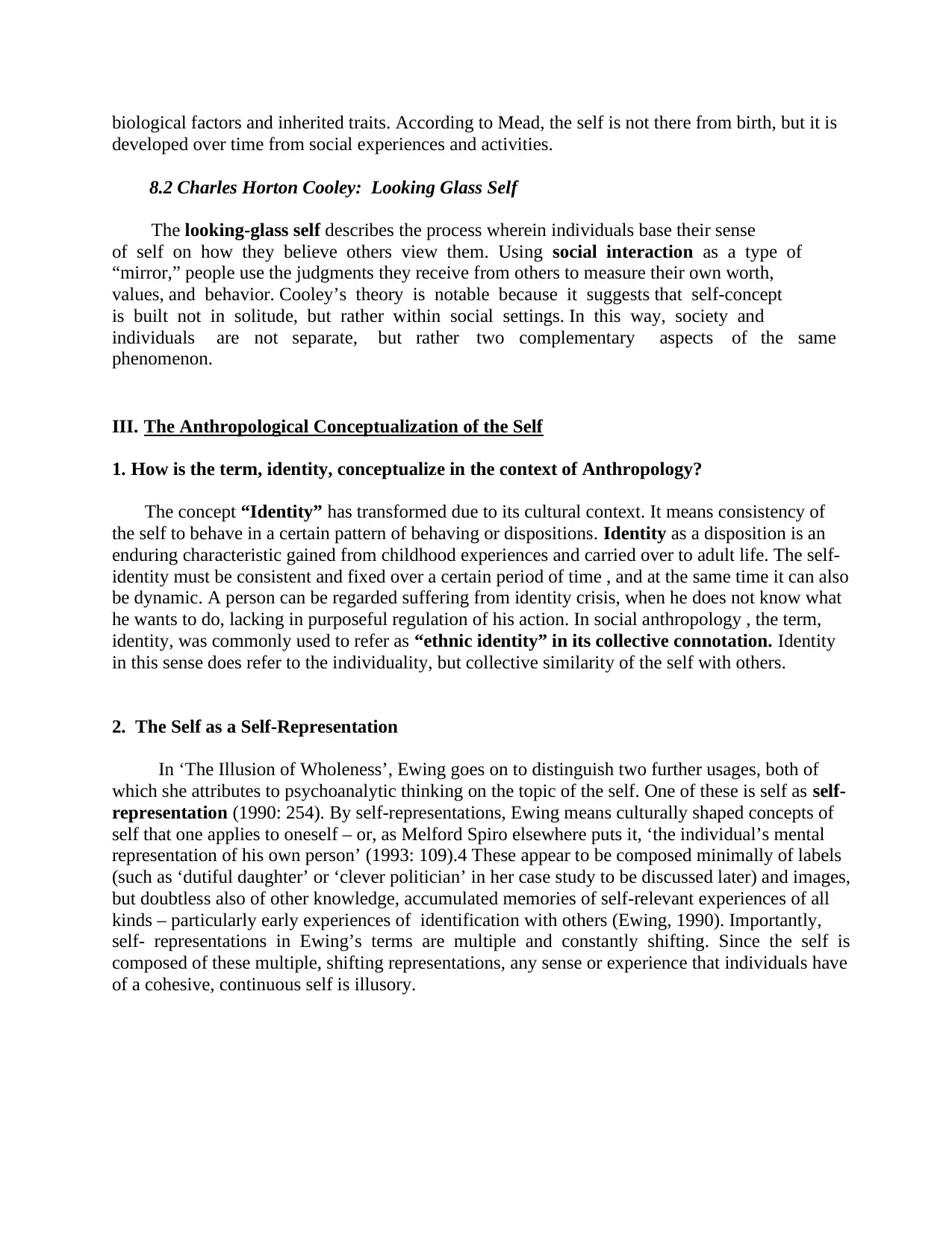
biological factors and inherited traits. According to Mead, the self is not there from birth, but it is
developed over time from social experiences and activities.
8.2 Charles Horton Cooley: Looking Glass Self
The looking-glass self describes the process wherein individuals base their sense
of self on how they believe others view them. Using social interaction as a type of
“mirror,” people use the judgments they receive from others to measure their own worth,
values, and behavior. Cooley’s theory is notable because it suggests that self-concept
is built not in solitude, but rather within social settings. In this way, society and
individuals are not separate, but rather two complementary aspects of the same
phenomenon.
III. The Anthropological Conceptualization of the Self
1. How is the term, identity, conceptualize in the context of Anthropology?
The concept “Identity” has transformed due to its cultural context. It means consistency of
the self to behave in a certain pattern of behaving or dispositions. Identity as a disposition is an
enduring characteristic gained from childhood experiences and carried over to adult life. The self-
identity must be consistent and fixed over a certain period of time , and at the same time it can also
be dynamic. A person can be regarded suffering from identity crisis, when he does not know what
he wants to do, lacking in purposeful regulation of his action. In social anthropology , the term,
identity, was commonly used to refer as “ethnic identity” in its collective connotation. Identity
in this sense does refer to the individuality, but collective similarity of the self with others.
2. The Self as a Self-Representation
In ‘The Illusion of Wholeness’, Ewing goes on to distinguish two further usages, both of
which she attributes to psychoanalytic thinking on the topic of the self. One of these is self as self-
representation (1990: 254). By self-representations, Ewing means culturally shaped concepts of
self that one applies to oneself – or, as Melford Spiro elsewhere puts it, ‘the individual’s mental
representation of his own person’ (1993: 109).4 These appear to be composed minimally of labels
(such as ‘dutiful daughter’ or ‘clever politician’ in her case study to be discussed later) and images,
but doubtless also of other knowledge, accumulated memories of self-relevant experiences of all
kinds – particularly early experiences of identification with others (Ewing, 1990). Importantly,
self- representations in Ewing’s terms are multiple and constantly shifting. Since the self is
composed of these multiple, shifting representations, any sense or experience that individuals have
of a cohesive, continuous self is illusory.
developed over time from social experiences and activities.
8.2 Charles Horton Cooley: Looking Glass Self
The looking-glass self describes the process wherein individuals base their sense
of self on how they believe others view them. Using social interaction as a type of
“mirror,” people use the judgments they receive from others to measure their own worth,
values, and behavior. Cooley’s theory is notable because it suggests that self-concept
is built not in solitude, but rather within social settings. In this way, society and
individuals are not separate, but rather two complementary aspects of the same
phenomenon.
III. The Anthropological Conceptualization of the Self
1. How is the term, identity, conceptualize in the context of Anthropology?
The concept “Identity” has transformed due to its cultural context. It means consistency of
the self to behave in a certain pattern of behaving or dispositions. Identity as a disposition is an
enduring characteristic gained from childhood experiences and carried over to adult life. The self-
identity must be consistent and fixed over a certain period of time , and at the same time it can also
be dynamic. A person can be regarded suffering from identity crisis, when he does not know what
he wants to do, lacking in purposeful regulation of his action. In social anthropology , the term,
identity, was commonly used to refer as “ethnic identity” in its collective connotation. Identity
in this sense does refer to the individuality, but collective similarity of the self with others.
2. The Self as a Self-Representation
In ‘The Illusion of Wholeness’, Ewing goes on to distinguish two further usages, both of
which she attributes to psychoanalytic thinking on the topic of the self. One of these is self as self-
representation (1990: 254). By self-representations, Ewing means culturally shaped concepts of
self that one applies to oneself – or, as Melford Spiro elsewhere puts it, ‘the individual’s mental
representation of his own person’ (1993: 109).4 These appear to be composed minimally of labels
(such as ‘dutiful daughter’ or ‘clever politician’ in her case study to be discussed later) and images,
but doubtless also of other knowledge, accumulated memories of self-relevant experiences of all
kinds – particularly early experiences of identification with others (Ewing, 1990). Importantly,
self- representations in Ewing’s terms are multiple and constantly shifting. Since the self is
composed of these multiple, shifting representations, any sense or experience that individuals have
of a cohesive, continuous self is illusory.
⊘ This is a preview!⊘
Do you want full access?
Subscribe today to unlock all pages.

Trusted by 1+ million students worldwide
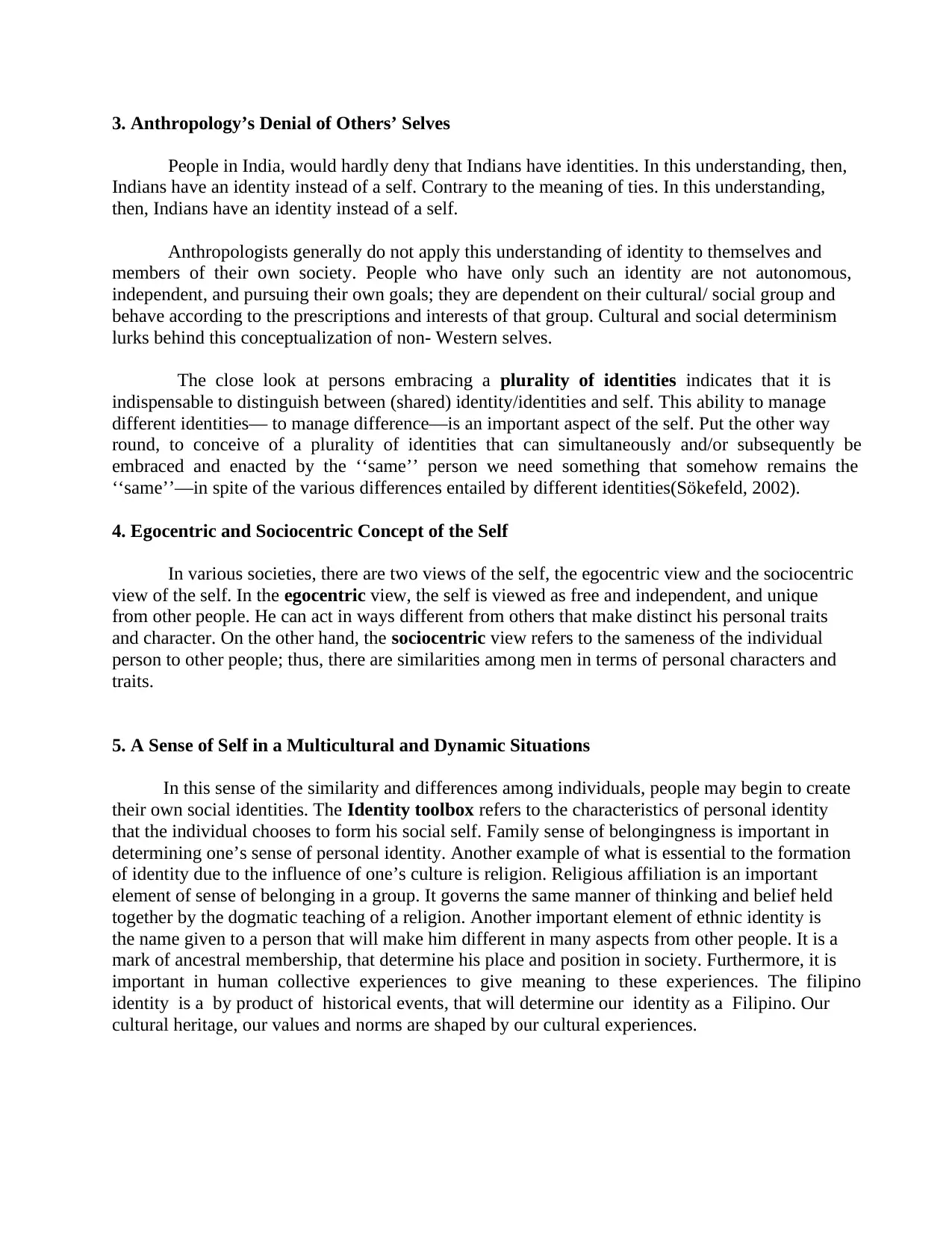
3. Anthropology’s Denial of Others’ Selves
People in India, would hardly deny that Indians have identities. In this understanding, then,
Indians have an identity instead of a self. Contrary to the meaning of ties. In this understanding,
then, Indians have an identity instead of a self.
Anthropologists generally do not apply this understanding of identity to themselves and
members of their own society. People who have only such an identity are not autonomous,
independent, and pursuing their own goals; they are dependent on their cultural/ social group and
behave according to the prescriptions and interests of that group. Cultural and social determinism
lurks behind this conceptualization of non- Western selves.
The close look at persons embracing a plurality of identities indicates that it is
indispensable to distinguish between (shared) identity/identities and self. This ability to manage
different identities— to manage difference—is an important aspect of the self. Put the other way
round, to conceive of a plurality of identities that can simultaneously and/or subsequently be
embraced and enacted by the ‘‘same’’ person we need something that somehow remains the
‘‘same’’—in spite of the various differences entailed by different identities(Sökefeld, 2002).
4. Egocentric and Sociocentric Concept of the Self
In various societies, there are two views of the self, the egocentric view and the sociocentric
view of the self. In the egocentric view, the self is viewed as free and independent, and unique
from other people. He can act in ways different from others that make distinct his personal traits
and character. On the other hand, the sociocentric view refers to the sameness of the individual
person to other people; thus, there are similarities among men in terms of personal characters and
traits.
5. A Sense of Self in a Multicultural and Dynamic Situations
In this sense of the similarity and differences among individuals, people may begin to create
their own social identities. The Identity toolbox refers to the characteristics of personal identity
that the individual chooses to form his social self. Family sense of belongingness is important in
determining one’s sense of personal identity. Another example of what is essential to the formation
of identity due to the influence of one’s culture is religion. Religious affiliation is an important
element of sense of belonging in a group. It governs the same manner of thinking and belief held
together by the dogmatic teaching of a religion. Another important element of ethnic identity is
the name given to a person that will make him different in many aspects from other people. It is a
mark of ancestral membership, that determine his place and position in society. Furthermore, it is
important in human collective experiences to give meaning to these experiences. The filipino
identity is a by product of historical events, that will determine our identity as a Filipino. Our
cultural heritage, our values and norms are shaped by our cultural experiences.
People in India, would hardly deny that Indians have identities. In this understanding, then,
Indians have an identity instead of a self. Contrary to the meaning of ties. In this understanding,
then, Indians have an identity instead of a self.
Anthropologists generally do not apply this understanding of identity to themselves and
members of their own society. People who have only such an identity are not autonomous,
independent, and pursuing their own goals; they are dependent on their cultural/ social group and
behave according to the prescriptions and interests of that group. Cultural and social determinism
lurks behind this conceptualization of non- Western selves.
The close look at persons embracing a plurality of identities indicates that it is
indispensable to distinguish between (shared) identity/identities and self. This ability to manage
different identities— to manage difference—is an important aspect of the self. Put the other way
round, to conceive of a plurality of identities that can simultaneously and/or subsequently be
embraced and enacted by the ‘‘same’’ person we need something that somehow remains the
‘‘same’’—in spite of the various differences entailed by different identities(Sökefeld, 2002).
4. Egocentric and Sociocentric Concept of the Self
In various societies, there are two views of the self, the egocentric view and the sociocentric
view of the self. In the egocentric view, the self is viewed as free and independent, and unique
from other people. He can act in ways different from others that make distinct his personal traits
and character. On the other hand, the sociocentric view refers to the sameness of the individual
person to other people; thus, there are similarities among men in terms of personal characters and
traits.
5. A Sense of Self in a Multicultural and Dynamic Situations
In this sense of the similarity and differences among individuals, people may begin to create
their own social identities. The Identity toolbox refers to the characteristics of personal identity
that the individual chooses to form his social self. Family sense of belongingness is important in
determining one’s sense of personal identity. Another example of what is essential to the formation
of identity due to the influence of one’s culture is religion. Religious affiliation is an important
element of sense of belonging in a group. It governs the same manner of thinking and belief held
together by the dogmatic teaching of a religion. Another important element of ethnic identity is
the name given to a person that will make him different in many aspects from other people. It is a
mark of ancestral membership, that determine his place and position in society. Furthermore, it is
important in human collective experiences to give meaning to these experiences. The filipino
identity is a by product of historical events, that will determine our identity as a Filipino. Our
cultural heritage, our values and norms are shaped by our cultural experiences.
Paraphrase This Document
Need a fresh take? Get an instant paraphrase of this document with our AI Paraphraser
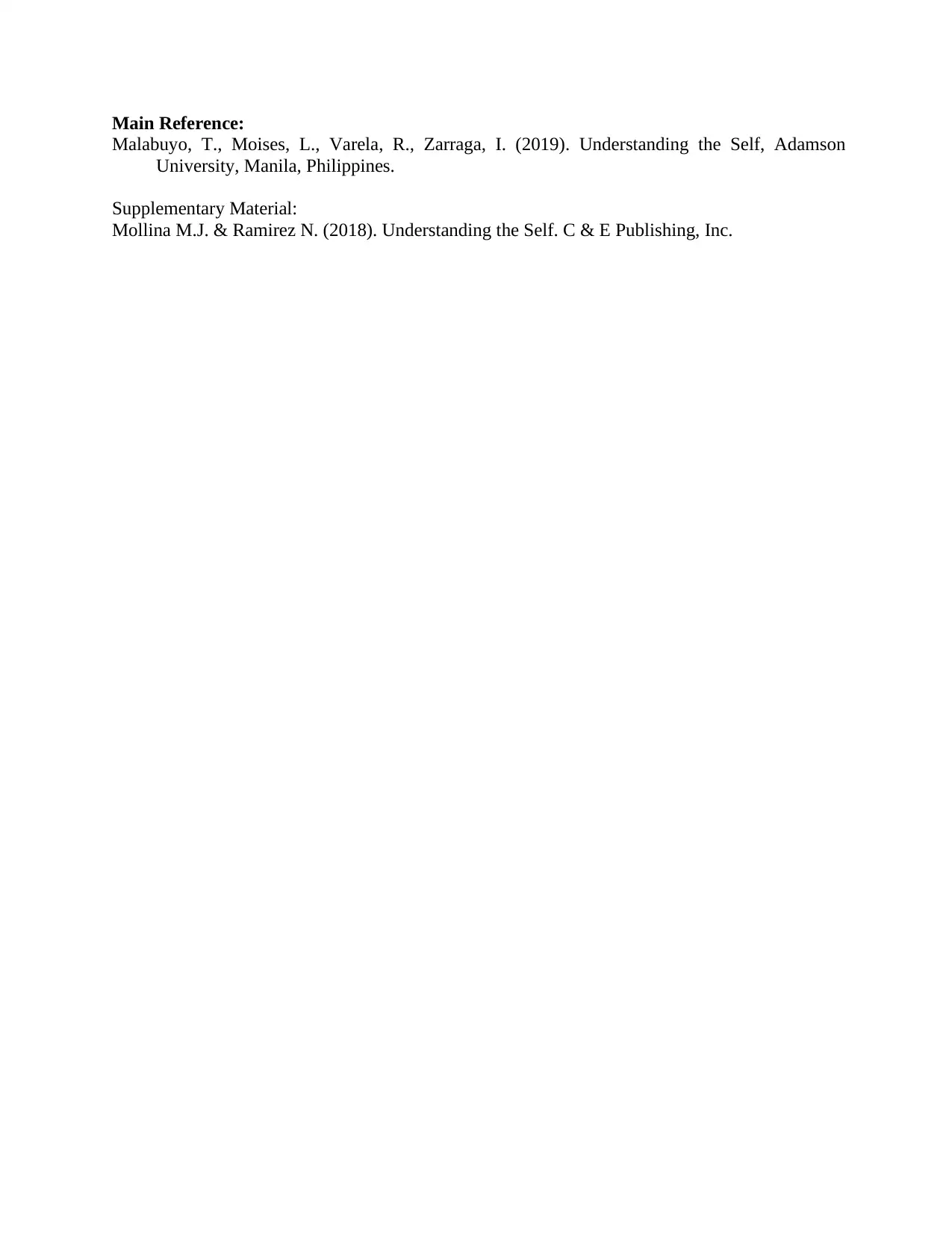
Main Reference:
Malabuyo, T., Moises, L., Varela, R., Zarraga, I. (2019). Understanding the Self, Adamson
University, Manila, Philippines.
Supplementary Material:
Mollina M.J. & Ramirez N. (2018). Understanding the Self. C & E Publishing, Inc.
Malabuyo, T., Moises, L., Varela, R., Zarraga, I. (2019). Understanding the Self, Adamson
University, Manila, Philippines.
Supplementary Material:
Mollina M.J. & Ramirez N. (2018). Understanding the Self. C & E Publishing, Inc.
1 out of 8
Related Documents
Your All-in-One AI-Powered Toolkit for Academic Success.
+13062052269
info@desklib.com
Available 24*7 on WhatsApp / Email
![[object Object]](/_next/static/media/star-bottom.7253800d.svg)
Unlock your academic potential
Copyright © 2020–2025 A2Z Services. All Rights Reserved. Developed and managed by ZUCOL.




